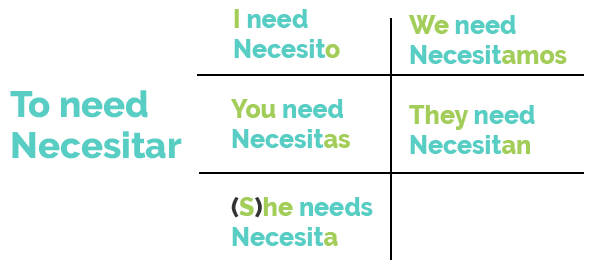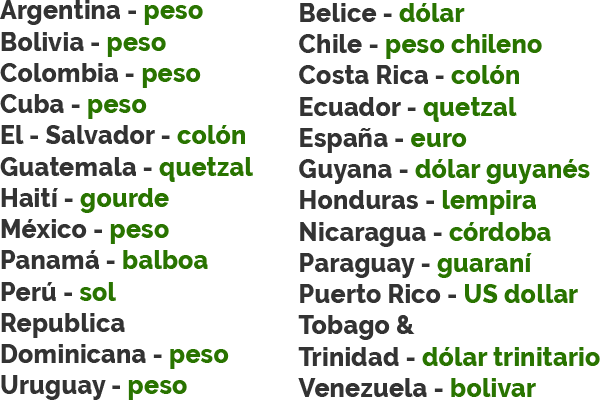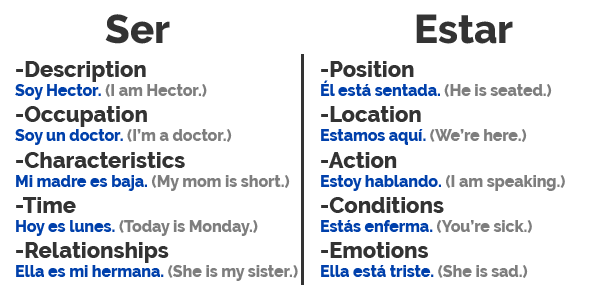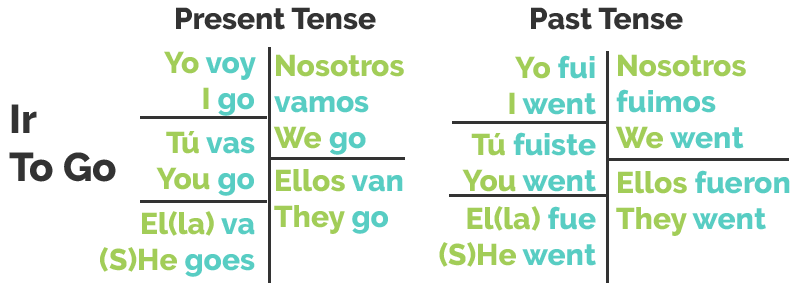Spanish
Key:
Subject | Object | Verb | Adjective | Adverb1
At the StoreBienvenidos is the most common way to say welcome, but, in this case, the barista is speaking to one female, so he used bienvenida. In Spanish, adjectives change endings based on someone’s gender. -a = one female, -o = one male, -as = more than one female, and -os = a group that includes at least one male. So, if there’s a group of 99 females and one male (lucky guy), it would still be bienvenidos.
In Spanish, you can often “drop” the subject because the verb implies who the speaker is talking about.
So, the -as in Necesitas implies that the speaker is talking about you. You also don’t need the Do as it is also implied in the question marks and the inflection of the speaker’s voice.
The one Spanish word, Necesitas, does all three jobs of the three English words: Do, you, and need. Pretty cool, huh?
The verb ayudar (to help) is used here in the Affirmative form, also known as the Command form. In Spanish, commands can add the object of the command to the end of the verb. Another acceptable way to say “Help me” is “Me ayuda.”
In Spanish, the verb, gustar (to like) literally translates to it pleases me. So, the store is doing the action (pleasing) to the speaker, Amanda. Therefore, the verb gustar conjugates (changes) based on the subject doing the pleasing. If the sentence said, “I like these stores a lot,” it would translate to, “Me gustan mucho estas tiendas.” If you like multiple things, use the verb gustan.
Just like Necesitas in the first line, Amanda was able to drop the subject because the -o in the verb Quiero implies that she is talking about herself.
Querer is a stem-changing verb, meaning that the conjugation is irregular. In every conjugation (except nosotros), there is an i added before the first e.
Again, it’s important to notice what the subject of the sentence is because that affects how you’re going to conjugate the verb. In this sentence, “¿Cuánto cuesta?,” the subject is the implied coffee because it is the thing that is doing the action, (costing). This is important to note because if the subject was plural, the verb cuesta would change to cuestan.
LITERAL TRANSLATION. Audio
This is a simple example of when English and Spanish syntax (sentence structure) line up exactly: Subject | verb | object. Don’t let this throw you off, though. The syntax isn’t always like this.
Keep in mind that this example uses American dollars (USD), dolares but the country that you’re visiting may not accept it. Here’s a list of Spanish-speaking countries and their currencies: 
The literal translation of Lo siento is I feel it with the -o in siento implying the subject of yo.
In Spanish, there are two different ways of saying you, Usted and tú. In this example, Habla, Amanda is using usted.
Usted is generally used when speaking to someone that you don’t know very well or is in a respectable position, such as a professor or doctor. Amanda is using it here to be respectful to the barista.
Tú is used with friends and acquaintances. The barista used it with Amanda to be more conversational and friendly while asking her, Necesitas ayuda.
Notice that the verbs are conjugated differently based on which subject is used, even for usted and tú which essentially mean the same word, you.
Audio
It may seem strange to say No back-to-back in the same sentence, but it’s not a typo. In Spanish, verbs become negative by simply adding no before the verb. So, the first No (before the comma) was answering the question and the second no (after the comma) has the purpose of making the verb, hablo, negative.
If the speaker chose to include the subject (remember it’s optional), the sentence would read as follows: No, yo no hablo inglés.
LITERAL TRANSLATION. Audio
Demasiado is an adjective describing dinero.
In Spanish, adjectives change endings based on the noun that they’re describing. If the object was feminine (with an -a ending) the adjective would also end with -a.
Tengo is an irregular verb in many ways. The base verb is tener, but a lot happens to it when it conjugates. Try to memorize this conjugation chart.
LITERAL TRANSLATION. Audio
LITERAL TRANSLATION. Audio
Comprarlo is a combination of the infinitive of a verb and a direct object. You can only add the direct object to the end of a verb when it is in its infinitive form, meaning not conjugated. A tip to see if a verb is still in the infinitive form is to see if it still ends with -er, -ar, or -ir. If it does, it hasn’t been conjugated yet and the direct object that it’s affecting can be added onto the end. If the verb is conjugated
, the direct object goes before the verb. So, this phrase could be rewritten as, “Lo quiero comprar.”LITERAL TRANSLATION. Audio
LITERAL TRANSLATION. Audio
2
IntroductionsLlamarse is yet another reflexive verb, which may cause some confusion for new Spanish learners. The direct translation of me llamo Amanda is, “I call myself Amanda. Weird, I know, but it’s a very common way to introduce yourself. It’s interesting due to the fact that the object and the subject are both the person being introduced. So, if someone asked what your brother’s name is, you would respond with, “Se llama Enrique.” “He calls himself Enrique“.
LITERAL TRANSLATION. Audio
If you look at the next sentence in this section, you’ll see that Hector uses both estoy and soy to say the phrase I am. Estoy comes from the verb estar, meaning to be. Soy comes from the verb ser, also meaning to be. So, what’s the difference?
Think of estar as temporary and ser as permanent. Below is a list of the different use cases for ser and estar.
Now that you understand the different use cases for ser and estar, it’s time to learn the different conjugations.
LITERAL TRANSLATION. Audio
Fui is the first use of the preterite form. Preterite simply means past tense. Fui is the preterite form of the verb ir, which is an irregular verb in both tenses.
Llegué is in the preterite, one of the possible past tenses in Spanish. For the verb llegar, the yo conjugation (llegué) is irregular. This has a reason, though. If llegar followed traditional preterite conjugation standards, it would turn into llege and lose the “g” sound. In Spanish, a -ge is pronounced like an “h” sound in English. The u and accent mark over the e are added to maintain that hard g sound. Hover over the question mark icon at the end of the sentence to listen to the audio.

LITERAL TRANSLATION. Audio
LITERAL TRANSLATION. Audio
LITERAL TRANSLATION. Audio
LITERAL TRANSLATION. Audio
LITERAL TRANSLATION. Audio
LITERAL TRANSLATION. Audio
LITERAL TRANSLATION. Audio
LITERAL TRANSLATION. Audio
LITERAL TRANSLATION. Audio ][/audio]
LITERAL TRANSLATION. Audio
LITERAL TRANSLATION. Audio
3
At the RestaurantLITERAL TRANSLATION. Audio
LITERAL TRANSLATION. Audio
LITERAL TRANSLATION. Audio
LITERAL TRANSLATION. Audio
LITERAL TRANSLATION. Audio
LITERAL TRANSLATION. Audio
LITERAL TRANSLATION. Audio
LITERAL TRANSLATION. Audio
LITERAL TRANSLATION. Audio
LITERAL TRANSLATION. Audio
LITERAL TRANSLATION. Audio
LITERAL TRANSLATION. Audio
LITERAL TRANSLATION. Audio
Vocabulary List
- Quién Who
- Qué What
- Cuándo When
- Dónde Where
- Por qué Why
- Comó How
- Cuánto How much
- No entiendo I don’t understand
- Más despacio, por favor. More slowly, please.
- Lo siento/perdón Sorry
- ¿Puede repetir, por favor? Can you repeat that?
- ¿Cómo se dice ____ en español? How do you say ____ in Spanish?
- No sé I don’t know
- ¿Qué significa ____? What does ____ mean?
- Ayúdame Help me
- Puedes You can
- ¿De verdad? Really?
- Quiero I want
- Quieres You want
- Necesito I need
- Tienes You have
- Tiene You have (usted)
- Tenemos We have
- Tengo que I have to
- Me gusta(n) I like
- Me voy (Voy a) I go(ing to)
- Te gustaría You would like (Would you like…?)
- Fui I went
- Yo soy I am
- Es It is
- Comer Eat
- Beber Drink
- Trabajo I work
- Vivo I live
- Me quedo I stay
- Comprar Buy
- Me llamo My name is
- Necesitas You need
- Tengo I have
- Te gusta(n) You like
- Puedo I can
- Podemos We can
- Nos vamos (Vamos a) We go(ing to)
- Me gustaría I would like
- Tú eres You are
- Estoy I am (estar)
- Estás You are (estar)
- Está It is (estar)
- Hablo I speak
- Habla/Hablas You speak
- Como I eat
- Bebo I drink
- Vives You live
- Creo que I believe
- Tengo hambre I’m hungry
- Perdón Excuse me
- Por Favor Please
- Nuestro/Nuestra Our
- Entonces Then
- Ahora Now
- Luego Later
- Después After
- Desde Since
- Aquí Here
- Hay There is/There are
- Demasiado/Demasiada Too much
- Solo Only
- Mucho Very much (A lot)
- Juntos/juntas Together
- Conmigo With me
- Fiesta Party
- Restaurante Restaurant
- Hotel Hotel
- Comida Food
- Agua Water
- Esta noche Tonight
- Pronto Soon
- Gracias Thank you
- Hola Hello
- Señora Madam
- Señor Sir
- Adios Goodbye
- También Also/Too
- Ayuda Help
- Yo I
- Tú You
- Nosotros We
- Ellos/Ellas They
- Mi My
- Tu Your
- Ahí/Allí/Allá There
- Antés Before
- Pero But
- Dinero Money
- Hasta Until
- Años Years
- Él/Ella He/she
- Hoy Today
- Mañana Tomorrow
- Ayer Yesterday
- Próximo Next
- Última Last
- Tal vez Maybe
- Muy Very
- Aunque Even though (although)
- Algun(os/as) Some
- Izquierdo Left
- A la derecha Right
- Derecho Straight
- Direcciones Direction
- Cerca Near
- Lejos Far




